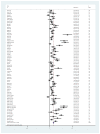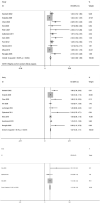Homocysteine and Folic Acid: Risk Factors for Alzheimer's Disease-An Updated Meta-Analysis
- PMID: 34122042
- PMCID: PMC8188894
- DOI: 10.3389/fnagi.2021.665114
Homocysteine and Folic Acid: Risk Factors for Alzheimer's Disease-An Updated Meta-Analysis
Abstract
Background: Recent studies have reported that homocysteine (Hcy) may play a vital role in the pathogenesis of vascular dementia (VaD) and Alzheimer's disease (AD). Our study explored the relationship between the plasma Hcy and folate levels and the risk of dementia. Methods: We searched Embase, PubMed, and Web of Science for published literature, including case-control studies and prospective cohort studies, and performed a systematic analysis. Results: The results of our meta-analysis, consisting of case-control studies, showed higher levels of Hcy and lower levels of folate in dementia, AD, and VaD patients than those in non-demented controls (for dementia: SMD = 0.812, 95% CI [0.689, 0.936], p = 0.000 for Hcy; SMD = -0.677, 95% CI [-0.828, -0.525], p = 0.000 for folate). AD patients showed significantly lower plasma Hcy levels compared to VaD patients (SMD = -0.278, 95% CI [-0.466, -0.09], p = 0.000). Subgroup analysis revealed that ethnicity, average age, and dementia type had no significant effect on this association. Furthermore, from the analysis of prospective cohort studies, we identified that elevated plasma Hcy levels were associated with an increased risk of dementia, AD, and VaD (RRdementia = 1.22, 95% CI [1.08, 1.36]; RRAD = 1.07, 95% CI [1.04, 1.11]; RRVaD = 1.13, 95% CI [1.04, 1.23]). In addition, every 5 μmol/L increase in the plasma Hcy level was associated with a 9% increased risk of dementia and a 12% increased risk of AD. Conclusion: Hcy and folic acid are potential predictors of the occurrence and development of AD. A better understanding of their function in dementia could provide evidence for clinicians to rationalize clinical intervention strategies.
Keywords: Alzheimer's disease; folic acid; homocysteine; meta-analysis; vascular dementia.
Copyright © 2021 Wang, Zhao, Chang, Liu and Zhu.
Conflict of interest statement
The authors declare that the research was conducted in the absence of any commercial or financial relationships that could be construed as a potential conflict of interest.
Figures







References
Publication types
LinkOut - more resources
Full Text Sources

